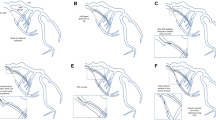Abstract
Intravascular ultrasound (IVUS) is a fundamental tool in coronary intervention for chronic total occlusion (CTO) lesions. Although IVUS can identify the entry even for stumpless lesions, this technique needs a large side branch to accommodate an IVUS probe. On the other hand, computed tomography (CT)–guided coronary intervention, which recently reported a higher success rate for CTO lesions, has the advantage of identification of entry points and occluded routes. We herein report a case with an abrupt type CTO who was successfully recanalized with CT guidance, although IVUS failed to clarify the entry.
A 66-year-old man was referred to our department for pre-operative evaluation. His electrocardiogram showed exercise-induced ST-T segment depression, and coronary angiography revealed a CTO in the mid-left circumflex artery, which was treated via bilateral distal radial approaches. However, the entry point of the CTO could not be clarified by bilateral coronary angiography or IVUS, because the entry was at the trifurcation with a small branch. On the other hand, coronary CT angiography demonstrated the occluded route and the precise morphology of the entry point, allowing successful treatment of the CTO.
Cardiac CT is useful to reveal the accurate position and precise morphology of the entry cap of CTO, even if IVUS guidance could not be applicable because there is no large side branch close to the abrupt entry.
Similar content being viewed by others
Explore related subjects
Discover the latest articles, news and stories from top researchers in related subjects.Avoid common mistakes on your manuscript.
Introduction
Intra-coronary imaging is recommended as a helpful guide for coronary stent implantation, particularly in cases involving the left main artery or complex lesions by the guideline [1]. Recently, a randomized study demonstrated that intra-coronary imaging–guided percutaneous coronary intervention (PCI) led to a lower risk of a composite of death from cardiac causes, target-vessel–related myocardial infarction, or clinically driven target-vessel revascularization than angiography-guided PCI among patients with complex coronary artery lesions [2]. Especially for chronic total occlusion (CTO) lesions, intravascular ultrasound (IVUS) is a fundamental tool in PCI [3]. One of the advantages of IVUS is the identification of a CTO entry in the abrupt type lesions. An IVUS probe accommodated in a side branch can reveal the accurate position of the entry when there is a sufficiently large side branch close to the abrupt type entry. However, this technique is not able to apply to all cases.
We herein report a case with an abrupt type CTO, in whom IVUS failed to clarify the entry while cardiac computed tomography (CT) guidance successfully recanalized.
Case Presentation
A 66-year-old man with dyslipidemia, diabetes, and previous smoking history was referred to our department for pre-operative evaluation of rectal cancer. Although he did not complain of chest pain, his electrocardiogram showed exercise-induced ST-T segment depression, and the cardiac CT scan demonstrated stenosis in all 3 coronary arteries. Coronary angiography revealed moderate stenoses in the right coronary artery and the left anterior descending artery and a CTO in the left circumflex artery (Fig. 1) with collaterals from the right coronary artery. As the moderate lesions were insignificant by the fractional flow reserve measurement, we decided to treat the CTO via bilateral distal radial approaches. Coronary angiography could not clarify the entry point of the CTO (Fig. 1), and IVUS accommodated in the posterior lateral branch also could not reveal the entry except for the ostium of a small branch (Fig. 2, Online Resource 1). On the other hand, the thin-slab maximum intensity projection image of coronary CT angiography demonstrated the occluded route and the entry positioning at the trifurcation with the small branch (Fig. 3). Then, we put a guide wire (Gaia Next 1, Asahi Intecc, Japan) in the small branch, pulled it back with rotation, and finally succeeded in hooking the entry and crossing the lesion (Fig. 4, Online Resource 2). After balloon inflations, IVUS examination through the CTO lesion confirmed successful wiring at the trifurcation (Fig. 5, Online Resource 3). We used a 2.0 × 20 mm drug-coated balloon (SeQuent Please Neo, B. Braun, Germany), and the final result showed good opacification of the occluded segment with mild delay (Fig. 6).
Percutaneous coronary intervention to the chronic total occlusion lesion in the left circumflex artery. After inserting a guide wire in the small branch (left panel, arrow), we pulled back it with rotation and finally succeeded in hooking the entry and crossing the lesion (right panel, arrow). Arrowheads indicate a guide wire in the posterior lateral branch
Discussion
CT-guided PCI has been recently developing, and an expert consensus document on pre-procedural planning of coronary revascularization by cardiac CT was published [4]. Several studies investigated the usefulness of pre-procedural evaluation by CT in CTO lesions and reported several scoring systems to predict procedural success. A recent study by Hong et al. demonstrated that pre-procedural cardiac CT guidance resulted in higher success rates in PCI for CTO with a lower trend of immediate peri-procedural complications [5]. Cardiac CT guidance is superior in accurately identifying entry points and occluded routes [6]. Therefore, cardiac CT is essential for creating a primary and secondary procedural plan and assessing the risk/benefit ratio of the PCI procedure for CTO lesions [7]. In this case, cardiac CT could clarify the stumpless entry, which was almost mistaken as a bifurcation with a small branch by IVUS pulling back through the posterior lateral branch because the entry was positioned at the trifurcation.
Proficient operators in IVUS examinations might be able to identify the entry correctly. The vessel diameter size was increased after the bifurcation with the small branch on the IVUS pulling back through the posterior lateral branch. The change in vessel diameter suggests that the side branch might be much larger, and the entry could locate there. In addition, the precise evaluation at the bifurcation is difficult due to the forward and backward motion of the IVUS probe by heartbeat. However, such an accurate judgment is complicated for most interventionists in catheterization laboratories. Even if we came up with this, we were not able to visualize the entry by IVUS because the side branch was too small to put an IVUS probe in. On the other hand, the CT image was clear and easy to understand, although we reconstructed the thin-slab maximum intensity projection images by ourselves on a workstation and could not scan in real-time during procedures.
Conclusions
Cardiac CT is useful to reveal the accurate position and precise morphology of the entry cap of the CTO and is helpful to succeed in complex interventions.
Data Availability
All medical data and materials are kept in the electronic medical record of the patient and can only be accessed by health personnel taking part in the patient’s medical care. Please contact the corresponding author to request details regarding this case.
References
Lawton JS, Tamis-Holland JE, Bangalore S, Bates ER, Beckie TM, Bischoff JM, et al. 2021 ACC/AHA/SCAI guideline for coronary artery revascularization. J Am Coll Cardiol. 2022;79:e21-129.
Lee JM, Choi KH, Song Y Bin, Lee J-Y, Lee S-J, Lee SY, et al. Intravascular imaging–guided or angiography-guided complex PCI. N Engl J Med. 2023. https://doi.org/10.1056/NEJMoa2216607
Di Mario C, Mashayekhi KM, Garbo R, Pyxaras SP, Ciardetti N, Werner GW. Recanalisation of coronary chronic total occlusions. EuroIntervention. 2022;18:535–61.
Andreini D, Collet C, Leipsic J, Nieman K, Bittencurt M, De Mey J, et al. Pre-procedural planning of coronary revascularization by cardiac computed tomography. J Cardiovasc Comput Tomogr. 2022;16:558–72.
Hong S-J, Kim B-K, Cho I, Kim H-Y, Rha S-W, Lee S-H, et al. Effect of coronary CTA on chronic total occlusion percutaneous coronary intervention. JACC Cardiovasc Imaging. 2021;14:1993–2004.
Sadamatsu K, Okutsu M, Sumitsuji S, Kawasaki T, Nakamura S, Fukumoto Y, et al. Practical utilization of cardiac computed tomography for the success in complex coronary intervention. Cardiovasc Interv Ther. 2021;36:178–89.
Brilakis ES, Mashayekhi K, Tsuchikane E, Abi Rafeh N, Alaswad K, Araya M, et al. Guiding principles for chronic total occlusion percutaneous coronary intervention. Circulation. 2019;140:420–33.
Author information
Authors and Affiliations
Contributions
KS and TK were the operators of the procedure. KS, TK, and MS were in charge of treating the patient. KS and YF mainly contributed to the interpretation of images and drafting of the manuscript. All authors read and approved the final manuscript.
Corresponding author
Ethics declarations
Ethics Approval
Local ethic committee approved this publication.
Consent for Publication
The written informed consent for publication of the case and images were obtained from the patient.
Conflict of Interest
The authors declare no competing interests.
Additional information
Publisher's Note
Springer Nature remains neutral with regard to jurisdictional claims in published maps and institutional affiliations.
Supplementary Information
Below is the link to the electronic supplementary material.
Supplementary file1 Online Resource. 1 Intravascular ultrasound pulling back from the posterior lateral branch. The ostium of the small branch was positioned at 7 o'clock between frames 174 and 224. (MOV 2294 KB)
Supplementary file2 Online Resource. 2 Antegrade wiring for the chronic total occlusion lesion in the left circumflex artery. We pulled back a guide wire in the small branch with rotation and finally succeeded in hooking the entry and crossing the lesion. (MP4 3077 KB)
Supplementary file3 Online Resource. 3 Intravascular ultrasound examination through the occluded lesion after balloon inflations demonstrated the entry point at the trifurcation with the posterior lateral branch at 1 o'clock and the small branch at 3 o'clock. The trifurcation was shown between frames 91 and 96. A guide wire was put in the posterior lateral branch.(MP4 6898 KB)
Rights and permissions
Springer Nature or its licensor (e.g. a society or other partner) holds exclusive rights to this article under a publishing agreement with the author(s) or other rightsholder(s); author self-archiving of the accepted manuscript version of this article is solely governed by the terms of such publishing agreement and applicable law.
About this article
Cite this article
Sadamatsu, K., Kugai, T., Shihara, M. et al. Usefulness of Cardiac Computed Tomography–Guided Coronary Intervention for a Stumpless Total Occlusion: a Case Report. SN Compr. Clin. Med. 5, 137 (2023). https://doi.org/10.1007/s42399-023-01476-2
Accepted:
Published:
DOI: https://doi.org/10.1007/s42399-023-01476-2










